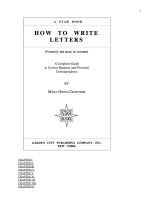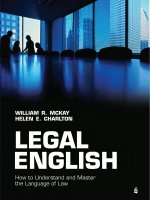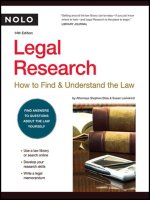Legal English: How to understand and master the language of law pptx
Bạn đang xem bản rút gọn của tài liệu. Xem và tải ngay bản đầy đủ của tài liệu tại đây (3.04 MB, 197 trang )
Legal English is designed to assist those who wish to develop and enhance their skills in the use of the English
language within a legal context, whether as a native English speaker or someone using English as a second or
foreign language.
It enables the reader to confidently write on, and discuss, legal topics as well as actually conduct legal work –
such as advocacy, interviewing and advising, negotiation, legal writing and drafting. The book provides the
necessary tools to build on language skills in a professional context through familiarisation with realistic legal
scenarios and materials prepared by a qualified lawyer. The exercises are suited to both self-study and group work.
Legal English:
● includes exercises which progressively enhance communication skills in oral and written English
● develops legal vocabulary alongside grammatical construction and pronunciation
● presents realistic legal scenarios to advance professional language skills
● enhances the study process through the inclusion of learning objectives, glossary of terminology,
sample letters, legal documentation and contracts
Legal English is ideal for those studying law within an English language jurisdiction. It is also an invaluable
reference for those involved in the legal or business domain whose work brings them into contact with legal
practice.
William R. McKay is a qualified solicitor and Lecturer at the Inns of Court School of Law, Institute of Law, City
University, London. He currently teaches civil litigation, civil advocacy, opinion writing and drafting and employment
law on the Bar Vocational Course. He is also part-time lecturer for legal reasoning and employment law at
Birkbeck College, University of London.
Helen E. Charlton (MA, TEFL) has taught English as a foreign language for several leading language schools. She
teaches Business English to clients from major corporations and has worked in Japan.
www.pearson-books.com
‘This is a much needed text on legal English. It deserves a place on the shelf of every law teacher, and should be
on the reading list of all students who need to get to grips with language issues… An excellent and up-to-date
book that makes the resolution of language law issues accessible and interesting.’
Dr Sharon Hanson (PhD), Director of Legal Studies Programmes, Birkbeck College, University of London
‘This book fills a very important gap and will be gratefully appreciated by both students and teachers of legal
English. It is an authoritative introduction to a field which is becoming more and more significant internationally.’
David Rowson, MBE, Head of English, Bellerbys College, London
MCKAY AND CHARLTON
LEGAL ENGLISH
LEGAL ENGLISH
MCKAY AND CHARLTON
How to Understand and Master the Language of Law
Cover image © Getty Images
0582894360_COVER(McKay) 28/2/05 1:48 pm Page 1
Legal English
01PRELIM 03/07/2005 10:19 AM Page i
We work with leading authors to develop the strongest
educational materials in law, bringing cutting-edge thinking
and best learning practice to a global market.
Under a range of well-known imprints, including Longman, we craft
high quality print and electronic publications which help readers to
understand and apply their content, whether studying or at work.
To find out more about the complete range of our
publishing, please visit us on the World Wide Web at:
www.pearsoned.co.uk
01PRELIM 03/07/2005 10:19 AM Page ii
Legal English
How to Understand and Master the Language of Law
William R. McKay and
Helen E. Charlton
01PRELIM 03/07/2005 10:19 AM Page iii
Pearson Education Limited
Edinburgh Gate
Harlow
Essex CM20 2JE
England
and Associated Companies throughout the world
Visit us on the World Wide Web at:
www.pearsoned.co.uk
Published 2005
© Pearson Education Limited 2005
The rights of William R. McKay and Helen E. Charlton to be identified as authors
of this work have been asserted by the authors in accordance with the Copyright,
Designs and Patents Act 1988.
All rights reserved. No part of this publication may be reproduced, stored in
a retrieval system, or transmitted in any form or by any means, electronic,
mechanical, photocopying, recording or otherwise, without either the prior
written permission of the publisher or a licence permitting restricted copying
in the United Kingdom issued by the Copyright Licensing Agency Ltd,
90 Tottenham Court Road, London W1T 4LP.
ISBN 0-582-89436-0
British Library Cataloguing-in-Publication Data
A catalogue record for this book is available from the British Library
Library of Congress Cataloging-in-Publication Data
A catalog record for this book is available from the Library of Congress
10 9 8 7 6 5 4 3 2 1
08 07 06 05
Typeset in 10/13pt Palatino by 69
Printed by Ashford Colour Press Ltd, Gosport
The publisher’s policy is to use paper manufactured from sustainable forests.
01PRELIM 03/07/2005 10:19 AM Page iv
Acknowledgements vii
Introduction 1
Part 1 Business law and practice 3
1. Company formation 5
2. Board meetings 16
3. Shareholders' meetings 21
4. Boardroom battle! 32
5. Marketing agreements 45
Part 2 Civil litigation 57
6. Injunctions 59
7. Breach of contract claim 66
8. Road traffic accident! 76
9. Trial 90
10. Employment law 120
Part 3 Law bulletin 129
11. Law bulletin 131
Appendix 1: Study and research
guide 149
Appendix 2: Glossary 158
Appendix 3: Answer key 165
Index 185
v
Table of contents
01PRELIM 03/07/2005 10:19 AM Page v
01PRELIM 03/07/2005 10:19 AM Page vi
The publishers and authors would like to thank the following individuals and pub-
lications for granting permission to reproduce copyright material.
Employment Tribunals Service for permission to include sample copies of Employ-
ment Tribunal forms.
The Law Society Gazette for permission to reproduce the following articles:
■ ‘Shopping Around’ (edition dated 4 March 2004)
■ ‘Having cross words in the courtroom’ (edition dated 1 April 2004)
■ ‘Asian tigers prepare to spring’ (edition dated 20 May 2004).
Nigel Hanson for permission to reproduce ‘Shopping Around’. Nigel Hanson is a
member of the media team at Foot Anstey Sargent.
Justin Michaelson (Weil, Gotshal & Manges) on behalf of the Solicitors’ Associa-
tion of Higher Court Advocates, for permission to reproduce ‘Having cross words
in the courtroom’.
Lucy Trevelyan for permission to reproduce ‘Asian tigers prepare to spring’.
Margot Taylor, Principal Lecturer at the Inns of Court School of Law, for permis-
sion to reproduce her article entitled 'Which route – solicitor or barrister?’ (The Times,
20 January 2004).
The authors would also like to express their gratitude to Sharon Hanson and
David Ronson for providing valued comments and feedback in the course of this
book being written.
vii
Acknowledgements
Publisher’s note
The following forms are © Crown copyright: v 08/02 (10: First directors and
secretary and intended situation of registered office); 10/03 (12: Declaration on
application for registration); 288a (Appointment of director or secretary); N19
(Special Resolution on Change of Name Companies Acts); N1 Claim form (CPR
Part 7) (01.02); IT1 (E/W) (Application to an Employment Tribunal); Form IT3
E&W – 8/98 (Employment Tribunals); Human Rights Act 1998.
While every care has been taken to establish and acknowledge copyright and to
contact the copyright owners, the publishers tender their apologies for any acciden-
tal infringement. They would be pleased to come to a suitable arrangement with the
rightful owners in each case.
01PRELIM 03/07/2005 10:19 AM Page vii
01PRELIM 03/07/2005 10:19 AM Page viii
This book has been written to assist those interested in law and wishing to become
more conversant in English within a legal context (whether as a native English
speaker or someone using English as a second or foreign language). It is therefore
intended to be of assistance to a variety of individuals, including:
■ those aiming to study or presently studying law within an English language
jurisdiction (whether for academic or vocational training purposes)
■ those presently involved in the legal or business domain whose work brings
them into contact with legal practice.
Communication skills in oral and written legal English are developed through
a programme of language activity in conjunction with key legal skills training
including:
■ advocacy
■ interviewing and advising
■ negotiation
■ legal writing and drafting
In this way this publication offers the reader stimulating and enjoyable instruction
designed to progressively enhance relevant and meaningful communication skills
in oral and written legal English. Such a task based approach enables the reader to
optimise academic and professional effectiveness, offering a valuable source for aca-
demic and professional development. Legal English provides the opportunity to
build on language skills in a professional context through familiarisation with real-
istic legal scenarios and materials prepared by a qualified lawyer. The exercises are
suited to both self-study and group study in a classroom.
Readers therefore benefit from pro-active skills based exercises. These involve the
use of realistic legal precedents to develop a working knowledge of legal practice
and ability in performing ‘real-life’ legal tasks and procedures–all in the context of
improving the reader’s ability to use legal English.
English is predominantly the language of international legal practice and its im-
portance to lawyers cannot be over-emphasised. The way in which one uses legal
English can therefore be crucial to professional success. Competence is developed
throughout the book in a logical sequence of ascending complexity. Exercises are
also cumulative, previous lessons being reinforced and built upon in subsequent ex-
ercises while also containing a practice and feedback element.
1
Introduction
02INTRO 03/07/2005 10:23 AM Page 1
The book consists of main sections on:
■ Litigation (including courtroom advocacy, court orders, court documentation, pa-
perwork used by court lawyers, case preparation and problem solving)
■ Business law (including company documentation, company meetings and resolu-
tions and commercial agreements)
These sections also include an explanation of basic legal principles (such as in
relation to the law of contract and tort) as well as a review of language and
grammar–all in the context of ‘portable’ skills training which will be of value in
many academic and professional contexts.
Additional sections on journalistic texts and legal research and study guidance
further contribute to making this a book of much value to readers wishing to de-
velop their legal English for use in the course of legal study or practice. It offers a
stimulating and enjoyable learning resource and can be used by readers with or
without any legal training. It will be of most use however to readers with at least an
upper intermediate standard in English language.
In each chapter you will be provided with an introduction to a different legal
topic. You are then provided with a range of language exercises relating to the legal
topic for that chapter.
These exercises involve legal skills practise and role-play (such as advocacy,
interviewing, negotiation and writing/drafting), enabling you to develop your pro-
ficiency in legal English. The areas of language and law in each chapter are then
summarised to consolidate your learning. Answers to the exercises are provided in
Appendix 3 and should be checked only after you have undertaken the exercises.
For further resources see www.pearsoned.co.uk/McKay
Introduction
2
02INTRO 03/07/2005 10:23 AM Page 2
PART 1
Business law and practice
03Chap01 03/07/2005 10:21 AM Page 3
03Chap01 03/07/2005 10:21 AM Page 4
5
Chapter 1 Company formation
Learning Objectives
By completing the exercises in this chapter you will:
■ Acquire knowledge of the legal characteristics and nature of a limited company
■ Acquire an appreciation of the vocabulary and grammar relevant to company law
■ Become aware of the information required in order to incorporate a company
■ Understand and be capable of explaining the legal procedures and documentation
required for company formation
■ Be able to prepare the legal documentation necessary in order to create a company
Company law
Characteristics of a company
A company is regarded in law as being a separate legal ‘person’, with a separate le-
gal personality. This means that it has rights separate from its owners and managers
to enter into contracts, employ people, own property and conduct business. The
creation and management of a company is governed by the Companies Act 1985
(CA ’85) and the Companies Act 1989.
By far the largest number of incorporated companies are incorporated with lim-
ited liability, being limited by shares as defined by section 1(2)(a) CA ’85. The
potential financial liability of a member (in other words shareholder) in such a com-
pany is limited to the amount, if any, remaining unpaid on the shares held by that
particular member. Such a company is known as a limited company and will have
the word ‘Limited’ at the end of its name.
A company can be a private or a public company. A public company must have a
minimum issued share capital of £50,000, as required by sections 11 and 118 CA ’85.
A public company may offer its shares for sale to the public (s. 81 CA ’85), whereas a
private company must not. A public company may also have its shares listed (and
traded) on the Stock Exchange. Information on the current values of such listed
shares is publicly available and can be checked for instance in The Financial Times.
03Chap01 03/07/2005 10:21 AM Page 5
COMPANY FORMATION
There are a number of legal requirements which must be complied with in order to incorporate
(in other words create) a company. In particular, the following documentation will normally be
required.
Memorandum of Association
The Memorandum of Association (known as the ‘articles of incorporation’ in the US) contains
the following information:
■ Name of the company
■ The company’s objects and powers (meaning basically the sphere of activities and nature of
the company)
■ The company’s share capital
Articles of Association
The Articles of Association (the articles) are in effect a set of rules governing the conduct of
the members of the company and its officers. The officers of a company are its directors and
company secretary. These rules commonly relate to matters such as the conduct of share-
holder and board meetings, any restriction on the transferability of shares and the powers
bestowed on the directors etc. (In the US the Articles of Association are known as the
bylaws.) Many companies use a standard form of articles known as ‘Table A Articles’.
Form 10
This is a standard form which must be completed with details of the intended officers of the
company, as required by s. 10(2) CA ’85. Every incorporated company must have at least one
director and one company secretary. (If there is to be only one director then that individual
cannot also be the company secretary.) Details of the company’s registered office (at
which formal documents will usually be served upon the company) should also be included in
Form 10.
Form 12
This is another standard form which must be signed by a person applying for incorporation of
the company to certify that the legal requirements for registration have been complied with.
The person signing Form 12 (commonly known as the promoter of the company) can be one of
the directors, the company secretary or a solicitor engaged in the formation of the company.
Once completed, these company documents must then be sent to the Registrar of Compa-
nies (‘the registrar’), along with a fee. The registrar then registers the company and issues a
Certificate of Incorporation. This is when the company comes into existence. There are further
legal requirements which the incorporated company must then continue to comply with, such
as having annual accounts prepared (s. 226 CA ’85), a copy of which must be filed annually at
Companies House (s. 242 CA ’85).
Exercise 1 – reading
Part 1 ■ Business law and practice
6
03Chap01 03/07/2005 10:21 AM Page 6
7
Answer the following questions concerning company formation, based on the above information.
1. What is meant by ‘limited liability’?
2. What is the minimum amount of issued share capital which a public company must
maintain?
3. List the four documents normally required in order to form a company.
4. If a client wishes to incorporate a company and be its only director, can s/he also be the
company secretary? If not then explain why not.
5. Name the document issued by the Registrar of Companies which is in effect a ‘birth certifi-
cate’ for a new company.
Exercise 2 – comprehension
Now assume that you are a lawyer in the Business Law Department of Stringwoods & Evans, a
city law firm located at 18 Bond Street, London, W1 1KR (telephone number 020 7538 2892;
DX number 12432, London 1). You have been instructed by a new client named Thomas
Shapiro (TS) to incorporate a company for him. TS is a successful entrepreneur with business
interests throughout Europe and the Far East. He now wishes to establish a private company
limited by shares to be named ‘Maplink Limited’. Maplink Limited will be run as a business,
publishing various maps and guides for tourists visiting London and other cities around the
world.
Your senior partner has already drafted the Articles of Association for Maplink Limited. You are
now required to complete the further documentation needed to form the company. This con-
sists of:
■ The Memorandum of Association
■ Form 10
■ Form 12
Taking account of the company details provided on p. 8, complete the following company for-
mation documentation accordingly by entering the correct details in the shaded spaces.
Exercise 3 – drafting
Chapter 1 ■ Company formation
▼
Language practice
03Chap01 03/07/2005 10:21 AM Page 7
Part 1 ■ Business law and practice
8
MAPLINK LIMITED – COMPANY PROFILE
REGISTERED OFFICE 44 Princess Diana Walk, South Kensington, London,
W2 3SL (Telephone no. 020 7429 8137)
DIRECTORS (1) MR THOMAS SHAPIRO of 23 Essex Street,
Hampton Court, Surrey, KT8 1NQ (Barrister – date
of birth 12 February 1968)
(2) PROFESSOR DIMITRIS YAVAPRAPAS of ‘The
Manor’, 2 Queen Elizabeth Street, London, SE1 5NP
(Surgeon - date of birth 3 July 1954)
COMPANY SECRETARY MISS GISELA WIRTH of 15 Robin Hood Way,
Mansfield, Nottingham, NG2 7CX (Accountant,
date of birth 28 November 1973)
AUTHORISED SHARE CAPITAL 250,000 X £1 Ordinary Shares
MEMBERS AND SHAREHOLDINGS THOMAS SHAPIRO 175,000
DIMITRIS YAVAPRAPAS 50,000
GISELA WIRTH 25,000
03Chap01 03/07/2005 10:21 AM Page 8
Chapter 1 ■ Company formation
9
▼
THE COMPANIES ACTS 1985 TO 1989
PRIVATE COMPANY LIMITED BY SHARES
MEMORANDUM OF ASSOCIATION OF [1]
1. The Company’s name is . [2]
2. The Company’s registered office is to be situated in England and Wales.
3. The object of the Company is to carry on business as a general commercial company.
4. The liability of the Members is . [3]
5. The Company’s share capital is £ [4] divided into 250,000 ordinary
shares of £1 each.
WE the subscribers to this Memorandum of Association wish to form into a Company
pursuant to this Memorandum and we agree to take the number of shares shown op-
posite our respective names.
Names and addresses of Subscribers Number of shares taken by each subscriber
THOMAS SHAPIRO
23 ESSEX STREET,
HAMPTON COURT,
SURREY, KT8 1NQ ONE HUNDRED AND SEVENTY-FIVE THOUSAND
1 [5]
FIFTY THOUSAND
2 [6]
3 [7]
Total shares taken : 4 [8]
Dated this 15 th. day of May 20 06
03Chap01 03/07/2005 10:21 AM Page 9
Part 1 ■ Business law and practice
10
03Chap01 03/07/2005 10:21 AM Page 10
Chapter 1 ■ Company formation
11
03Chap01 03/07/2005 10:21 AM Page 11
Part 1 ■ Business law and practice
12
03Chap01 03/07/2005 10:21 AM Page 12
Chapter 1 ■ Company formation
13
03Chap01 03/07/2005 10:21 AM Page 13
Complete the following sentences by entering an appropriate multi-word verb into each blank
space from the selection in the panel below.
1. The Defendant has decided to the judgment.
2. The judgment my client.
3. We are confident that the Judge will our opponent.
4. He wants to discussions with a view to becoming a director of the
company.
5. He intends to the company to purchase some shares.
6. I have been asked to a newly incorporated company.
Exercise 4 – multi-word verbs
contract for negotiate with act for
appeal against decide against enter into
Characteristics of a limited liability company
■ A limited company has a separate legal personality in law (as established by case of
Salomon v Salomon 1897)
■ A company is owned by shareholders, management decisions primarily being made by
directors
■ Shareholders (members) and directors have limited liability
■ A company must be registered at the Companies Registry (based in Cardiff for compa-
nies incorporated in England and Wales and in Edinburgh for companies incorporated
in Scotland)
■ A company comes into existence upon issue of a certificate of incorporation
■ Documents required to form a company: Memorandum of Association; Articles of
Association; Form 10; Form 12
■ Memorandum of Association indicates: the name of the company; whether it is a
private or public limited company; the objects of the company (which state the purpose
of the company and the scope of its legal capacity to conduct business with outside
parties)
■ Articles of Association provide a set of internal company rules
■ A shareholder’s personal liability is limited to paying fully for shares held
■ A company’s nominal (or authorised) share capital refers to the quantity of shares a com-
pany is authorised to issue (as indicated in the company’s Memorandum of Association)
Law notes
Part 1 ■ Business law and practice
14
03Chap01 03/07/2005 10:21 AM Page 14
■ A company’s issued share capital (also known as allotted share capital) refers to the
value of shares actually issued (or allotted) to shareholders
■ A company’s paid-up share capital refers to the amount of the total (nominal) value of
the issued share capital actually ‘paid-up’ by shareholders
■ There are various types of shares which a company can issue, including:
1. ordinary shares –usually carrying voting rights and a right to any dividend declared
by the company (i.e. share of any profits made by the company)
2. preference shares – which do not carry voting rights (referred to as non-voting
shares) but provide priority (i.e. a preference) to payment of a dividend
■ Continuing duty on company to maintain annual accounts and to file annual accounts
with Registrar of Companies
Multi-word verbs
Multi-word verbs consist of a verb and at least one particle. A particle is a word which
would be a preposition or an adverb in a different context. In this chapter you have
encountered several examples of multi-word verbs such as those in:
enter into a contract; comply with the requirements; subscribe their names to.
Multi-word verbs come in four categories:
1. verbs with particles and no object. E.g.
Sit down!
2. verbs with two particles. E.g. He gets on with his client.
3. verb
ϩ inseperable particle ϩ object. E.g. I’m waiting for the trial.
4. verb
ϩ separable particle ϩ object. E.g. He set out the terms / He set the terms out.
List of multi-word verbs
The following is a non-exhaustive list of examples of multi-word verbs used in legal English.
Grammar notes
Chapter 1 ■ Company formation
act for appeal against charge with
contract for decide for / against enter into
file for find against legislate for / against
negotiate with / for prohibit from rule against
settle for swear in withdraw from
15
03Chap01 03/07/2005 10:21 AM Page 15
16
Chapter 2 Board meetings
Learning Objectives
By completing the exercises in this chapter you will:
■ Understand and be capable of explaining the practice and procedure of board meetings
■ Be familiar with board meeting documentation
■ Develop your vocabulary in relation to company meetings
■ Acquire practice in drafting board meeting documentation
■ Develop word skills and vocabulary relevant to company law
■ Consider the use of relevant grammar including combining nouns and plural nouns
Introduction
In this chapter and the next one we will consider the practice and procedure of com-
pany meetings. These take two basic forms:
1. Board meetings
2. Shareholders’ meetings
We shall consider shareholders’ meetings in the next chapter. The main characteristics
of a board meeting (also known as a directors’ meeting) are as follows.
Board meetings
Board meetings are attended by the directors of the company. Day to day business
decisions are usually taken at board meetings. Matters to be decided upon are put
to the meeting in the form of ‘resolutions’, each director present casting a vote for
or against each resolution being considered. (Voting is usually by a ‘show of
hands’.) Whether or not a resolution is passed depends on whether the majority of
votes are in favour of or against that resolution. In other words the decision is
made by a simple majority. Multi-national companies with directors located inter-
nationally often stipulate in their articles that board meetings may be validly held
by means of telephone or audio-visual conferencing as well as via the internet.
04Chap02 03/07/2005 10:23 AM Page 16









